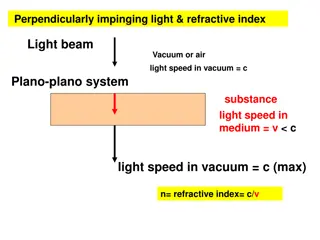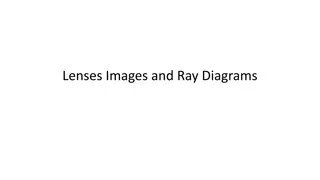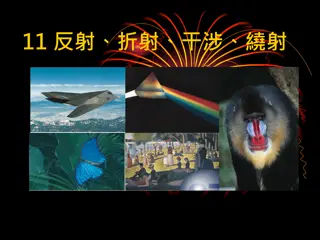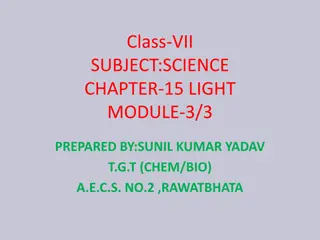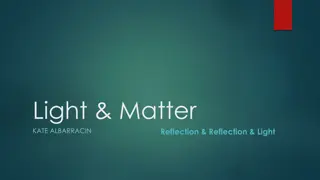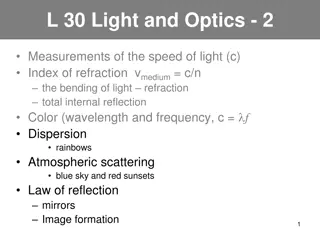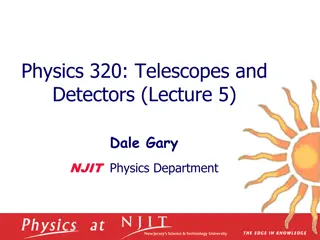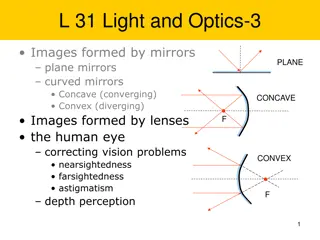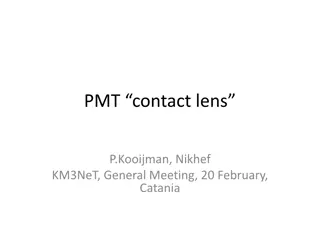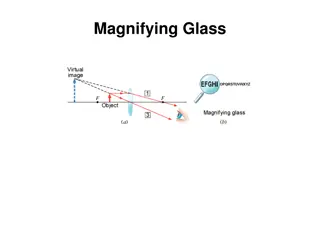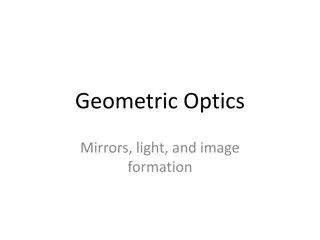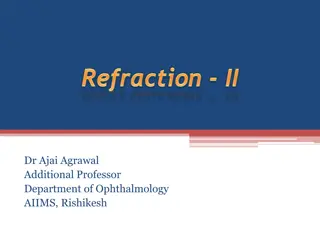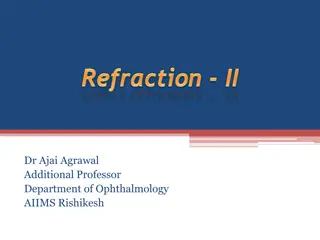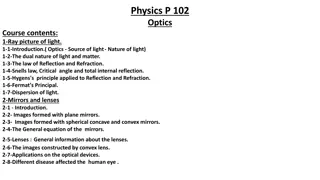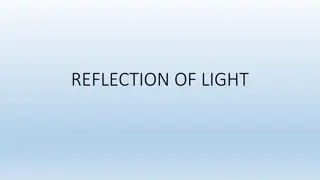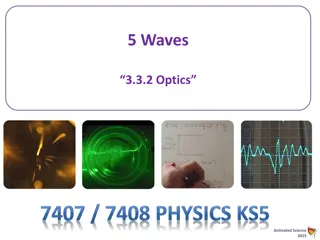Understanding Refraction and Lenses in Physics: Lecture 17 Insights
Explore the concepts of refraction, lenses, and indices of refraction in physics through Lecture 17 materials, including explanations on how light bends when traveling through different mediums, Snell's Law practice, examples, and interactive applets demonstrating refraction effects. Dive into topics such as the speed of light, behavior at boundaries, and parallel light rays crossing interfaces to deepen your understanding of these fundamental principles.
Download Presentation

Please find below an Image/Link to download the presentation.
The content on the website is provided AS IS for your information and personal use only. It may not be sold, licensed, or shared on other websites without obtaining consent from the author. Download presentation by click this link. If you encounter any issues during the download, it is possible that the publisher has removed the file from their server.
E N D
Presentation Transcript
Physics 1161: Lecture 17 Refraction & Lenses Textbook sections 26-3 26-5, 26-8
Indices of Refraction Physics 1161: Lecture 17, Slide 2
Checkpoint Refraction When light travels from one medium to another the speed changes v=c/n, but the frequency is constant. So the light bends: n1 1 1) n1 > n2 2 n2 2) n1 = n2 Compare n1 to n2. 3) n1 < n2
Checkpoint Refraction Which of the following is correct? n1 sin( 1)= n2 sin( 2) n1 1 2 n2 Compare n1 to n2. 1 < 2 1) n1 > n2 sin 1< sin 2 2) n1 = n2 3) n1 < n2 n1> n2
FST & SFA A ray of light crossing the boundary from a fast medium to a slow medium bends toward the normal. (FST) A ray of light crossing the boundary from a slow medium to a fast medium bends away from the normal. (SFA)
Example Snell s Law Practice Usually, there is both reflection and refraction! A ray of light traveling through the air (n=1) is incident on water (n=1.33). Part of the beam is reflected at an angle r = 60. The other part of the beam is refracted. What is 2? 1 r n1 n2 n1sin 1=n2sin 2 normal 2
Example Snell s Law Practice Usually, there is both reflection and refraction! A ray of light traveling through the air (n=1) is incident on water (n=1.33). Part of the beam is reflected at an angle r = 60. The other part of the beam is refracted. What is 2? 1 = r = sin(60) = 1.33 sin( 2) 1 r 2 = 40.6 degrees n1 n2 n1sin 1=n2sin 2 normal 2
Refraction Applets Applet by Molecular Expressions -- Florida State University Applet by Fu-Kwung Hwang, National Taiwan Normal University
Parallel light rays cross interfaces from air into two different media, 1 and 2, as shown in the figures below. In which of the media is the light traveling faster? 1. Medium 1 2. Medium 2 3. Both the same air air 2 1 0% 0% 0% 1 2 3
Parallel light rays cross interfaces from air into two different media, 1 and 2, as shown in the figures below. In which of the media is the light traveling faster? 1. Medium 1 2. Medium 2 3. Both the same air air 2 1 The greater the difference in the speed of light between the two media, the greater the bending of the light rays. 0% 0% 0% 1 2 3
Parallel light rays cross interfaces from medium 1 into medium 2 and then into medium 3. What can we say about the relative sizes of the indices of refraction of these media? 1. n1 > n2 > n3 2. n3 > n2 > n1 3. n2 > n3 > n1 4. n1 > n3 > n2 5. none of the above 1 2 3 0% 0% 0% 0% 0% 1 2 3 4 5
Parallel light rays cross interfaces from medium 1 into medium 2 and then into medium 3. What can we say about the relative sizes of the indices of refraction of these media? 1. n1 > n2 > n3 2. n3 > n2 > n1 3. n2 > n3 > n1 4. n1 > n3 > n2 5. none of the above Rays are bent toward the normal when crossing into #2, so n2 > n1. But rays are bent away from the normal when going into #3, so n3 < n2. How to find the relationship between #1 and #3? Ignore medium #2! So the rays are bent away from the normal if they would pass from #1 directly into #3. Thus, we have: n2 > n1 > n3 . 1 2 3 0% 0% 0% 0% 0% 1 2 3 4 5
Apparent Depth Light exits into medium (air) of lower index of refraction, and turns left.
Spear-Fishing Spear-fishing is made more difficult by the bending of light. To spear the fish in the figure, one must aim at a spot in front of the apparent location of the fish.
Apparent Depth Apparent depth: Apparent depth: d =dn2 n1 n n2 2 n n1 1 d d apparent fish apparent fish d d actual fish actual fish 50
To spear a fish, should you aim directly at the image, slightly above, or slightly below? 1. aim directly at the image 2. aim slightly above 3. aim slightly below 0% 0% 0% 1 2 3
To spear a fish, should you aim directly at the image, slightly above, or slightly below? 1. aim directly at the image 2. aim slightly above 3. aim slightly below 0% 0% 0% 1 2 3 Due to refraction, the image will appear higher than the actual fish, so you have to aim lower to compensate.
To shoot a fish with a laser gun, should you aim directly at the image, slightly above, or slightly below? 1. aim directly at the image 2. aim slightly above 3. aim slightly below 0% 0% 0% 1 2 3 The light from the laser beam will also bend when it hits the air-water interface, so aim directly at the fish.
Delayed Sunset The sun actually falls below below the horizon It "sets", a few seconds before we see it set.
Three Rays to Locate Image Ray parallel to axis bends through the focus. Ray through the focus bends parallel to axis. Ray through center of lens passes straight through.
Characterizing the Image Images are characterized in the following way 1. Virtual or Real 2. Upright or Inverted 3. Reduced, Enlarged, Same Size
Object Beyond 2f Image is Real Inverted Reduced
Object at 2f Image is Real Inverted Same size
Object Between 2f and f Image is Real Inverted Enlarged
Object at F No Image is Formed!
Object Closer than F Image is Virtual Upright Enlarged
Beacon Checkpoint A beacon in a lighthouse is to produce a parallel beam of light. The beacon consists of a bulb and a converging lens. Where should the bulb be placed? A. Outside the focal point B. At the focal point C. Inside the focal point
Lens in Water Checkpoint Focal point determined by geometry and Snell s Law: n1 sin( ) = n2 sin( ) n1<n2 P.A. F Fat in middle = Converging Thin in middle = Diverging Larger n2/n1 = more bending, shorter focal length. n1 = n2 => No Bending, f = infinity Lens in water has _________ focal length!
Lens in Water Checkpoint Focal point determined by geometry and Snell s Law: n1 sin( ) = n2 sin( ) n1<n2 P.A. F Fat in middle = Converging Thin in middle = Diverging Larger n2/n1 = more bending, shorter focal length. n1 = n2 => No Bending, f = infinity Lens in water has larger focal length!
Half Lens Checkpoint A converging lens is used to project a real image onto a screen. A piece of black tape is then placed over the upper half of the lens. 1. Only the lower half will show on screen 2. Only the upper half will show on screen 3. The whole object will still show on screen How much of the image appears on the screen?
Half Lens Checkpoint A converging lens is used to project a real image onto a screen. A piece of black tape is then placed over the upper half of the lens.
Half Lens Checkpoint Still see entire image (but dimmer)!
Two very thin converging lenses each with a focal length of 20 cm are are placed in contact. What is the focal length of this compound lens? 1. 10 cm 2. 20 cm 3. 40 cm 0% 0% 0% 1 2 3
Two very thin converging lenses each with a focal length of 20 cm are are placed in contact. What is the focal length of this compound lens? 1. 10 cm 2. 20 cm 3. 40 cm 0% 0% 0% 1 2 3
Concave (Diverging) Lens Ray parallel to axis refracts as if it comes from the first focus. Ray which lines up with second focus refracts parallel to axis. Ray through center of lens doesn t bend.
Image Formed by Concave Lens Image is always Virtual Upright Reduced
Concave Lens Image Distance As object distance decreases Image distance decreases Image size increases


